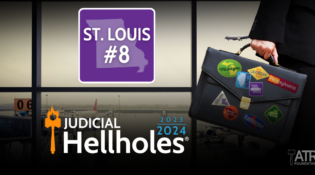“Dishonorable Mentions” generally comprise singularly unsound court decisions, abusive practices, legislation or other actions that erode the fairness of a state’s civil justice system, but aren’t otherwise discussed in other sections of the Judicial Hellholes report. This year’s report highlights rulings by the high courts of Arkansas, Indiana and Maryland.

2016 – 2017 Dishonorable Mentions
ARKANSAS SUPREME COURT: INVALIDATES BALLOT MEASURE LIMITING HEALTHCARE LIABILITY
After striking down many civil justice reforms enacted over the years, the Arkansas Supreme Court in October 2016 took yet another step in the wrong direction. In what one state senator dubbed the “state Supreme Court’s October Surprise,” the court invalidated a ballot initiative that would have allowed voters to amend the state constitution so it would allow lawmakers to place reasonable limits on civil liability for those who provide medical care.
“Issue 4” would have directed the state legislature to set caps of at least $250,000 on noneconomic damages in lawsuits against healthcare providers and limited an attorney’s contingency fees in medical malpractice cases to one-third of the award after expenses. Arkansas Attorney General Leslie Rutledge approved the initiated constitutional amendment. Canvassers gathered more than 130,000 signatures, leading to certification for the November ballot.
While noneconomic damages are widely understood to include awards for pain and suffering, the Arkansas Supreme Court ruled that voters could not reach an informed decision on the initiative unless its language was more clearly defined. Never mind that it was the state attorney generals’ office that had suggested placing the term “noneconomic damages” in the title of the initiative and didn’t feel the need to better define their plain meaning.
Although the issue appeared on the ballot, as a result of the high court’s decision, no votes were counted. While purportedly based on technical grounds, the ruling effectively ensured that voters could not override the court’s prior rulings and adopt laws in line with most other states. But members of the high court should understand that they can’t thwart the will of the People forever.
INDIANA SUPREME COURT: NULLIFIES STATUTE OF REPOSE
In March 2016 a divided Indiana Supreme Court eliminated the statute of repose for asbestos lawsuits in the state. The law had required plaintiffs to file a lawsuit within 10 years of their last exposure to the product that allegedly caused their injury.
The high court found in Myers v. Crouse-Hinds Division of Cooper Industries, that the Indiana Product Liability Act provides differing statutes of repose for claims by similarly situated plaintiffs. The Act distinguishes between entities that mined and sold raw asbestos and those that sold asbestos-containing products. This distinction, the court ruled, violates the Equal Privileges and Immunities Clause of the Indiana Constitution. In reaching its outcome, the Court overturned a prior decision.
This ruling effectively revives prior law, which did not close off claims involving asbestos-containing products after 10-years-from-last-exposure. Instead, plaintiffs may now bring such claims within two years of discovering disease and its cause, no matter how many years have elapsed. The change is expected to boost significantly asbestos lawsuit filings in the Hoosier State.
MARYLAND COURT OF APPEALS: TWO LIABILITY-EXPANDING DECISIONS
Typically considered moderate, the Maryland Court of Appeals (the state’s highest court) issued two liability-expanding decisions since publication of last year’s Judicial Hellholes report.
Late in 2015, the high court found that manufacturers of products with asbestos-containing parts are subject to liability even when a claimant’s alleged exposure was not to those original parts but to replacement parts made by others and installed much later by the claimant’s employer. In May v. Air & Liquid Systems Corp., a machinist sued companies that made steam-pumps for Navy ships, alleging that the manufacturers had a duty to warn him about the dangers of asbestos because they could foresee that asbestos-containing gaskets would need to be periodically replaced.
The court’s ruling, which concentrates on foreseeability, leapfrogs the bedrock requirement that a company is responsible for injuries stemming from its own product, not those of others. It places Maryland in the minority of states on this issue.
Maryland’s high court was at it again in July 2016, unanimously holding that a plaintiff’s verdict in a personal injury action does not prevent a subsequent wrongful death action based on the same facts. Typically, a plaintiff must assert all claims for injury in a single lawsuit. But Spangler v. McQuitty allows plaintiffs in Maryland to bring initial lawsuits for personal injuries and then, if those plaintiffs later die (as we all eventually will), their loved ones are allowed to bring a second lawsuit. The court reasoned that wrongful death is an independent statutory cause of action. As the court itself recognized, its decision is contrary to the law of most other states, which views a wrongful death claim as derivative of the initial personal injury action and therefore cannot be brought if a person has already brought a personal injury claim.
The decision occurred in the context of a medical malpractice case brought against an obstetrician and primary care physician by the parents of a child born with cerebral palsy. Healthcare providers and others are concerned that the decision will lead to duplicative awards and raise the cost of medical malpractice insurance.
Latest News

Junk Science Front and Center in Recent Judicial Hellholes Verdicts
The changes to Federal Rule of Evidence 702 last year were supposed to be a watershed moment for expert testimony
Judicial Hellholes
Chicago Juries Continue to Reject Junk Science, Attention Turns to Delaware
This week, a Chicago jury delivered Zantac manufacturers their second straight victory, refusing to find them liable for causing a
Points of Light
Plaintiffs’ Lawyers in Judicial Hellholes® Set Sights on New Vital Industry
ATRF has long chronicled the plaintiffs’ bars constant efforts to find their next payday. From hot coffee to baby powder,
Judicial Hellholes
